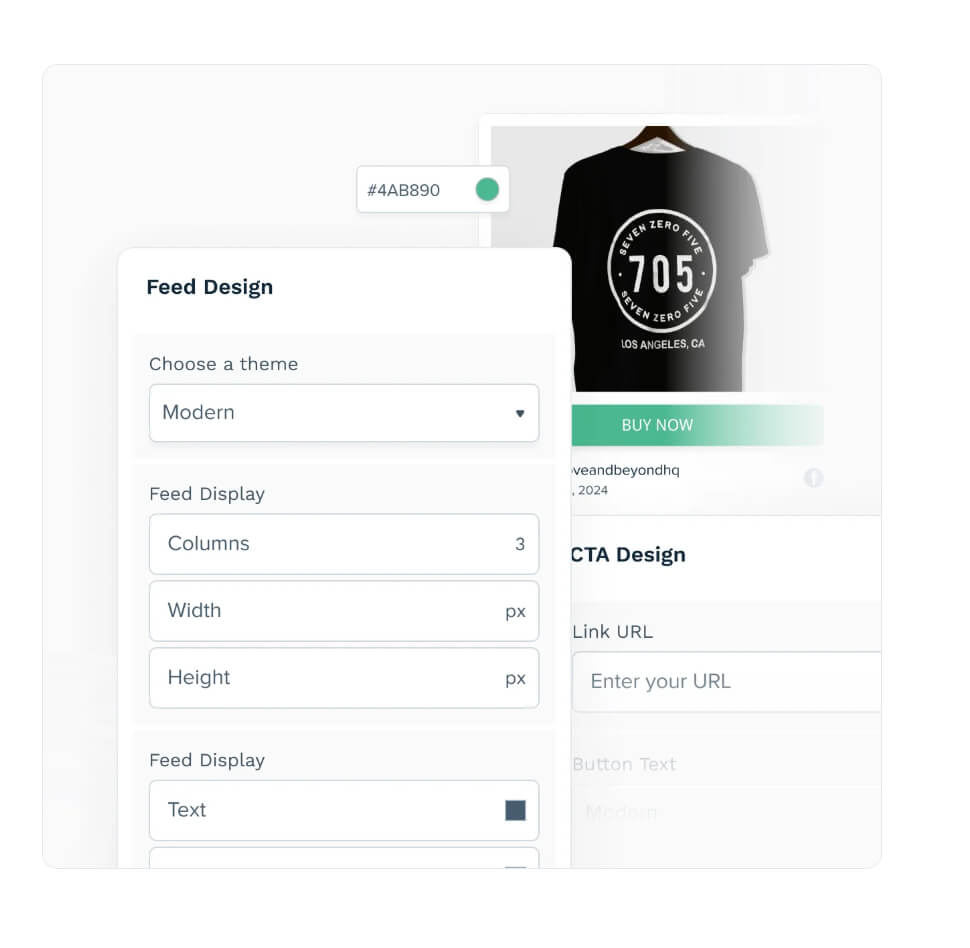Complete guide to integrating social walls with e-commerce
Everyone is shopping on social media. Knowingly and unknowingly. Grandmothers, Gen Z, and everyone in between. So is your online presence set up for that? And we mean: really optimized for it?
Because here’s what’s happening. Someone discovers your product on TikTok. They check you out on Instagram. Maybe they watch a few YouTube reviews. Then they land on your website and… nothing. No trace of that social energy that got them interested. No proof that other people actually love what you’re selling.
Your product pages feel like a museum compared to the vibrant social proof that brought customers to you in the first place.
Social commerce integration fixes this disconnect. Instead of pretending your website and social media live in separate worlds, you merge them into one experience. Customers see real people using your products, right where they’re ready to buy. Here’s our guide on how to do it right.

What is social commerce integration and why does it matter for e-commerce brands?
Let’s be honest about what social commerce integration really is, because it’s not putting some Instagram posts in your footer. It’s admitting that your polished product photos and carefully crafted descriptions aren’t enough anymore. It’s bringing the messy, authentic, convincing world of social media directly into your sterile shopping experience. And yes, that’s a good thing!
Traditional e-commerce pretends customers make rational decisions based on feature lists and specifications. If you’ve shopped recently, you know it’s not just about that. Social commerce integration acknowledges that people buy based on seeing others like them using and loving your products.
The trust problem we all feel, but not all brands fix
Your product descriptions sound like marketing copy because they are marketing copy. Your customer testimonials feel curated because they are curated. Your 5-star reviews look suspicious because everyone knows you can buy those now.
“The gap between discovery and purchase is where most sales die. Social commerce integration bridges that gap by keeping the social momentum alive through the entire buying process.”
What customers actually trust is that random person on TikTok who didn’t know you were watching when they raved about your product. The Instagram story where someone complained about the shipping but loved what they received. The YouTube review that mentions three things they didn’t like but still recommends your product. And instead of thinking this means it’s all out of your hands, you can take control of it.
Shopping behavior has evolved faster than most stores
Customers are researching products across multiple platforms before they even visit your website. They’re checking hashtags to see real usage. They’re looking for unboxing videos and honest reviews.
Then they arrive at your site and you’re still showing them the same static product shots every other brand uses.
The competitive advantage hiding in plain sight
Every brand has decent photography now. Professional models, clean backgrounds, perfect lighting – it’s all table stakes. Don’t even get us started on what AI will do to this. What separates successful brands is showing their products in action, being used and loved by real customers.
The difference is that most brands treat this social content like decoration. They are lost on social media platforms, with content that doesn’t work for live shopping. They think shoppable posts are unattainable. Social commerce integration makes that content work for conversions. And you can do that too.
How do you create a ‘shop social feed’ that drives conversions?
A shop social feed isn’t just your Instagram posts displayed on your website. A real shop social feed is a curated, dynamic display that connects social proof directly to purchase opportunities.
Start with content that actually matters
The best social commerce content isn’t coming from your brand account. It’s coming from customers who bought your stuff and shared their honest experiences without being asked.
Connect multiple platforms – Instagram, TikTok, Facebook, YouTube – to capture the full range of user generated content (UGC). Use hashtags strategically, but don’t rely on them exclusively. The most valuable content often doesn’t include your branded hashtags.
“The most convincing social proof looks like it wasn’t created for you. It looks like someone sharing something they genuinely love.”
Include the messy stuff alongside the pretty stuff. Unboxing videos where the lighting isn’t perfect. Styling posts where your product is part of a larger outfit. Reviews that mention minor complaints but still recommend your product. That’s how you truly leverage the power of influencer marketing. It works, because it doesn’t pretend there are no imperfections. Social media users know that, and appreciate the honesty when online shopping.
Make every post shoppable
This is where most brands lose the conversion opportunity. They show social content but don’t make it easy to act on the interest it creates.
Tag products in customer posts so viewers can click through immediately and make a purchase in just a few clicks. Link influencer content to specific collection pages. Connect review posts to product detail pages where customers can read more and purchase.
With Juicer, you can add custom call-to-action buttons that create direct paths from social proof to purchase. A customer’s skincare routine post becomes a “Shop This Routine” opportunity that takes viewers to a curated bundle.

Place it where purchase decisions actually happen
Where you put your shop social feed determines whether it converts browsers or just looks nice.
Homepage above the fold – Build trust immediately, before customers start judging your products.
Product detail pages – Answer the “will this work for me?” question with evidence from similar customers.
Collection pages – Help customers discover products through authentic styling and usage examples.
Checkout flow – Combat cart abandonment with last-minute social proof.
The goal isn’t to decorate your website with social content. It’s to provide social proof exactly when purchase doubt creeps in. Timing is everything here, and you are in control!
Moderate like a human, not a robot
You want authentic content, but you also need content that won’t embarrass your brand. The trick is filtering out the genuinely problematic stuff while keeping the realness that makes social proof work.
Auto-approve content from verified customers and established hashtags. Manually review anything from new sources. Filter out poor quality images and inappropriate content, but don’t sanitize away every imperfection.
Customers can tell when social proof has been over-curated. Again: a little messiness is more convincing than perfection.
How can you integrate a social retail display across your website and in-store touchpoints?
Social retail displays extend your social commerce strategy beyond your website. They create consistent social proof experiences across every place customers interact with your brand.
Website integration that actually works
Your social retail display should work regardless of what platform you built your store on. Shopify, WooCommerce, Magento, Squarespace – it shouldn’t matter.
Juicer provides embed codes that work with any CMS. You get one piece of code that you can drop anywhere you want social proof. No developer. No custom integration. No hoping it doesn’t break when you update your theme.

The display adapts to your existing design instead of fighting against it. Match your brand colors, choose layouts that fit your pages, customize the experience without starting from scratch.
In-store displays that bridge online and offline
Your physical retail locations should showcase the same social content that converts online customers. Digital displays create continuity between your online community and offline shopping experience.
Set up displays near high-consideration products or in areas where customers spend time deciding. Show customer reviews for products they’re currently handling. Update content automatically so your displays always feature fresh social proof.
For interactive kiosks, embed social walls that let customers browse user-generated content while they shop. They can see how others style your clothing or use your products in their actual lives.
Email and marketing integration
Your social retail display content doesn’t have to stay trapped on your website. Export top-performing customer posts for email campaigns, retargeting ads, or social media content.
Feature authentic customer content in abandoned cart emails. Include user-generated content in product recommendation emails. Use real customer posts in Facebook ads instead of expensive photoshoots.
Mobile optimization that doesn’t suck
Mobile customers interact with social content differently than desktop users. Your social retail display needs to be optimized for touch, fast loading, and smaller screens.
Use responsive layouts that work on any device. Ensure content loads quickly even on slower connections. Make buttons easy to tap without zooming.
If you have a mobile app, integrate social walls directly into product browsing and search results.
What content performs best in social commerce integration?
Not all social media content converts to sales. The most effective social commerce content solves specific doubts that arise during the purchase process.
Real usage in real situations
Posts showing your products being used in actual life perform better than staged product shots. Customers want to see how your clothing looks on different body types, how your furniture fits in normal homes, or how your beauty products apply in bathroom lighting.
Styling content helps customers visualize complete looks and combinations. One customer post showing your jacket styled three different ways sells more than a dozen professional product shots.
Before-and-after that proves results
Results-focused content works especially well for beauty, fitness, home improvement, and fashion brands. Customers need proof that your products deliver what you promise.
Before-and-after posts provide concrete evidence. They answer “will this actually work?” with visual proof instead of marketing claims.
Unboxing and first impressions
Unboxing content addresses concerns about product quality, packaging, and shipping experience. These posts build confidence in your entire brand experience, not just your products.
First-impression content captures authentic reactions that customers trust more than planned testimonials.
Problem-solving in action
Customer posts showing how they solved problems using your products demonstrate practical value. This content helps potential customers see applications they hadn’t considered.
Customer how-to content often performs better than brand-created tutorials because it feels more authentic and relatable.
What not to feature
Skip content that doesn’t directly support purchase decisions. Generic lifestyle posts, outdated seasonal content, or heavily filtered photos can actually hurt conversion rates.
Avoid featuring content with visible competitor products, truly negative comments about your brand, or posts that highlight customer service problems. Don’t ignore those posts though, they are a call for action.
Common social commerce integration mistakes (and how to avoid them)
Most brands make predictable mistakes when implementing social commerce. Here’s what typically goes wrong and how to get it right from the start.
Mistake 1: Treating social walls like wallpaper
Many brands add social content to their websites without connecting it to actual sales. They embed an Instagram feed in their footer and wonder why it doesn’t impact conversions.
The fix: Every piece of social content should have a clear path to purchase. Include product tags, collection links, or call-to-action buttons that connect social proof to buying opportunities.
Mistake 2: Over-curating authenticity away
Brands worry about showing “imperfect” customer content, so they only feature posts that look professional. This defeats the entire purpose of social proof.
The fix: Include a mix of polished and casual customer content. Focus on removing inappropriate content rather than only showing picture-perfect posts.
Mistake 3: Ignoring mobile reality
Social commerce content that looks great on desktop often fails miserably on mobile devices. Slow loading, tiny buttons, and cramped layouts kill conversions.
The fix: Test your social retail displays on actual mobile devices. Ensure fast loading, easy navigation, and thumb-friendly interactions.
Mistake 4: Set-it-and-forget-it content
Some brands manually upload social content and then forget about it. Stale content makes your brand look inactive and reduces trust.
The fix: Use automation tools like Juicer that pull in fresh content automatically. Set up regular review processes to keep your social walls current.
Mistake 5: No strategy behind the pretty pictures
Brands implement social commerce without clear goals for what content should accomplish. This leads to unfocused social walls that don’t drive conversions.
The fix: Define specific goals for each placement. Homepage social walls should build general trust. Product page content should address purchase concerns. Checkout content should reduce abandonment.
Getting started: Your social commerce setup checklist
Ready to implement social commerce integration? Here’s your step-by-step setup process:
Week 1: Content audit and strategy
✅ Audit existing customer content across social platforms
✅ Identify hashtags and accounts generating quality customer posts
✅ Define content guidelines and moderation standards
✅ Choose strategic placements for social retail displays
Week 2: Technical setup
✅ Connect social media accounts to Juicer
✅ Configure content filters and moderation settings
✅ Design social wall layouts that match your brand
✅ Generate embed codes for each placement
Week 3: Integration and testing
✅ Embed social walls on target pages
✅ Test mobile responsiveness and loading speeds
✅ Set up product tagging and call-to-action buttons
✅ Configure analytics tracking for performance monitoring
Week 4: Launch and optimization
✅ Monitor social wall performance and engagement
✅ Adjust content filters based on what’s working
✅ Expand to additional page placements
✅ Create processes for ongoing content management
Ongoing: Performance monitoring
✅ Track conversion rates on pages with vs. without social content
✅ Monitor customer engagement with social walls
✅ Update content strategy based on performance data
✅ Expand social commerce integration to new touchpoints
Measuring social commerce success
Social commerce integration should drive measurable business results. Here’s what actually matters:
Conversion metrics – Conversion rate differences on pages with social content – Time spent on product pages featuring social walls
– Click-through rates from social content to product pages – Cart abandonment rates with and without social proof
Engagement metrics – Interactions with social wall content
– Customer participation in hashtag campaigns – Social wall scroll depth and viewing time – User-generated content submission rates
Business impact – Revenue attributed to social commerce placements – Average order value for social commerce visitors
– Customer lifetime value for engaged customers – Cost per acquisition through social commerce
“Don’t measure social commerce success by social media metrics. Measure it by sales metrics that matter to your business.”
Track these monthly and adjust your strategy based on what’s actually driving revenue, not just engagement.
Stop letting social proof go to waste
Your customers are already creating content about your products. They’re sharing reviews, posting styling videos, and recommending your brand to their followers. The question isn’t whether you have enough content for social commerce integration.
The question is whether you’re using that content where it can actually influence purchase decisions.
Social commerce integration doesn’t require a bigger content budget or a social media team. It requires smart implementation of the authentic customer content that’s already being created for you every day.
Stop letting valuable social proof get buried in feeds where potential customers will never see it. Bring it to your website where it can actually turn browsers into buyers.
Ready to make your social content work harder for your business? Start your Juicer trial and see how social commerce integration works for your store.




